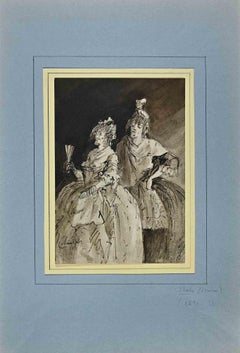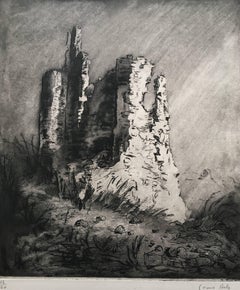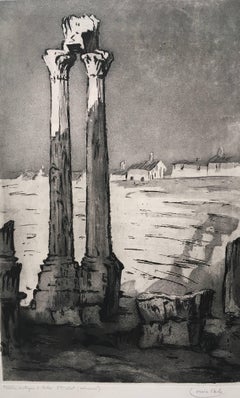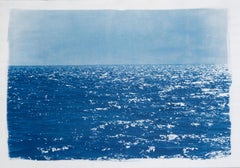Louise Ibels Art
to
3
3
2
1
Woman - Drawing by Louise Ibels - Early 20th century
By Louise Ibels
Located in Roma, IT
Women is an original drawing in Ink and Watercolor on paper realized by Ibels in the Early 20th Century.
Good conditions.
The artwork is depicted through soft strokes in a well-ba...
Category
Early 20th Century Modern Louise Ibels Art
Materials
Watercolor
Louise Ibels: Castle Ruins - Etching and Aquatint
By Louise Ibels
Located in London, GB
To see our other prints and architectural views, scroll down to "More from this Seller" and below it click on "See all from this Seller."
Louise Ibels (1891-1965)
Castle Ruins...
Category
Mid-20th Century Modern Louise Ibels Art
Materials
Etching, Aquatint
Louise Ibels: Arles Roman Theatre - Etching and Aquatint
By Louise Ibels
Located in London, GB
Louise Ibels (1891-1965)
'Théâtre Antique à Arles'
Etching and aquatint
Signed and titled in pencil to margin
3rd state proof
Approx. 39 x 25cm (plate...
Category
Mid-20th Century Modern Louise Ibels Art
Materials
Etching, Aquatint
Related Items
Coastal Blue Cyanotype of Day Time Seascape, Cold Waves, Nautical Painting Shore
By Kind of Cyan
Located in Barcelona, ES
This is an exclusive handprinted limited edition cyanotype.
"Day Time Seascape in Blue" is a handmade cyanotype print portraying the vibrant reflections of the Sun as seen from the c...
Category
2010s Modern Louise Ibels Art
Materials
Paper, Watercolor, Lithograph
'Brooklyn Bridge' — Iconic New York City Landmark
By Luigi Kasimir
Located in Myrtle Beach, SC
Luigi Kasimir, 'Brooklyn Bridge', color etching with aquatint, 1927, edition 100. Signed in pencil.
A superb impression, with fresh colors, on heavy, cream wove paper; with margins...
Category
1920s American Modern Louise Ibels Art
Materials
Etching, Aquatint
Palazzo, Florence
By Rudy O. Pozzatti
Located in Fairlawn, OH
Palazzo, Florence
Etching, engraving, aquatint, soft ground and lift ground, printed in colors from three copper plates. 1954
Signed in pencil lower right (see photo)
Edition 250 plis 10 on Rives wove paper, printed by the artist
Published by The Print Club of Cleveland, No. 33 for 1955
REFERENCE: Geske #32
Condition: Mint
Image size: 9 3/16 x 13 1/8 inches
Impressions of this image can be found in the following museums:
National Gallery of Art, Washington
Toledo Museum of Art
Oberlin, Allen Museum of Art
Cornell Univeristy
Cleveland Museum of Art
Indianapolis Museum of Art
Baltimore Museum of Art
Georgetown University
Indiana Univeristy, Eskenazi Museum of Art
David Museum of Art at Wellesley College
"Painter and printmaker Rudolph Otto "Rudy" Pozzatti was born in Telluride, Colorado, on January 14, 1925. Upon graduation from high school, he received a scholarship to attend the University of Colorado in Boulder where he enrolled as an art major. In 1943, his studies were interrupted by his induction into the U. S. Army. After his discharge in 1946, he re-enrolled in the University of Colorado where he studied under Wendell...
Category
1950s American Modern Louise Ibels Art
Materials
Aquatint
Central Park, Modern Aquatint Etching by Biagio Civale
Located in Long Island City, NY
Biagio Civale, Italian/American (1936 - ) - Central Park, Medium: Aquatint Etching, signed and numbered in pencil, Edition: 4/10, Image Size: 8 x 9.5 inches, Size: 19 in. x 22 in...
Category
1980s Modern Louise Ibels Art
Materials
Etching, Aquatint
Painter painting Don Quixote - Figurative Drypoint Print, Colorful, Polish Art
By Czeslaw Tumielewicz
Located in Warsaw, PL
Colorful figurative drypoint print by Polish artist Czeslaw Tumielewicz. Subject for this artwork comes from Miguel de Cervantes' book. The print is signed, it comes from edition lim...
Category
Early 2000s Contemporary Louise Ibels Art
Materials
Paper, Drypoint, Watercolor
$336 Sale Price
20% Off
H 8.27 in W 11.03 in
Central Park Zoo, New York City, Limited Edition Hand Colored Etching
By Cuca Romley
Located in Los Angeles, CA
This is a very hard to find hand colored etching of Central Park Zoo, New York City, well conserved in this excellent condition. It’s beautiful both for the skill: intricate details,...
Category
1970s Modern Louise Ibels Art
Materials
Etching, Ink, Watercolor
The glass mountain shattered David Hockney Fairy Tales from the Brothers Grimm
By David Hockney
Located in New York, NY
This etching from David Hockney’s celebrated Six Fairy Tales from the Brothers Grimm portfolio depicts the somewhat obscure story Old Rinkrank, which Hockney chose to illustrate beca...
Category
1960s Modern Louise Ibels Art
Materials
Etching, Aquatint
Rain Over Mountain, Modern Art in Blue Tones, Landscape, Cyanotype Monotype 2024
By Kind of Cyan
Located in Barcelona, ES
This is an exclusive handprinted unique cyanotype that takes its inspiration from the mid-century modern shapes.
It's made by layering paper cutouts and different exposures using uv-...
Category
2010s Modern Louise Ibels Art
Materials
Watercolor, Lithograph, Monotype, Paper
Don Quixote and apparition - Figurative Drypoint Print, Colorful, Polish Art
By Czeslaw Tumielewicz
Located in Warsaw, PL
Subject for this artwork comes from Miguel de Cervantes' book.
CZESLAW TUMIELEWICZ (b. 1942)
In 1968, he studied at the Architecture faculty of Gdank, before continuing his course a...
Category
Early 2000s Contemporary Louise Ibels Art
Materials
Paper, Watercolor, Drypoint
Rooftops (the harbor and skyline of NYC from Brooklyn rooftop)
By Frederick Mershimer
Located in New Orleans, LA
Moody, mysterious, majestic – these are some of the ways to describe the mezzotints of Frederick Mershimer. His images travel through the serenity of a Brooklyn neighborhood on a sti...
Category
Early 20th Century American Modern Louise Ibels Art
Materials
Mezzotint, Aquatint
$3,500
H 13.75 in W 23.69 in
Facing the Sun, Gyakko
By Shogo Okamoto
Located in San Francisco, CA
This artwork titled "Facing the Sun, Gyakko" is an original color aquatint by noted Japanese artist Shogo Okamoto, 1920-2001. It is hand signed, dated and numbered 62/100 in pencil b...
Category
Late 20th Century Modern Louise Ibels Art
Materials
Aquatint
Dulcinea - Figurative Drypoint Print, Colorful, Polish Art
By Czeslaw Tumielewicz
Located in Warsaw, PL
Subject for this artwork comes from Miguel de Cervantes' book. The print comes from edition limited to 5.
CZESLAW TUMIELEWICZ (b. 1942)
In 1968, he studied at the Architecture facul...
Category
2010s Contemporary Louise Ibels Art
Materials
Paper, Drypoint, Watercolor
$480
H 8.27 in W 11.03 in
Louise Ibels art for sale on 1stDibs.
Find a wide variety of authentic Louise Ibels art available for sale on 1stDibs. You can also browse by medium to find art by Louise Ibels in aquatint, etching, paint and more. Much of the original work by this artist or collective was created during the 20th century and is mostly associated with the modern style. Not every interior allows for large Louise Ibels art, so small editions measuring 10 inches across are available. Customers who are interested in this artist might also find the work of Eugene Corneau, Maxime Lalanne, and Jacques Beltrand. Louise Ibels art prices can differ depending upon medium, time period and other attributes. On 1stDibs, the price for these items starts at $267 and tops out at $452, while the average work can sell for $396.



